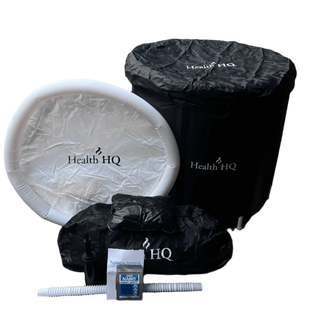Are There Any Risks or Potential Side Effects Associated With Using Ice Baths?
Ice baths—also known as cold plunges or cold water immersion—have exploded in popularity for their benefits in recovery, mental clarity, and inflammation reduction. But while the cold can do wonders, it’s also natural to wonder:
Are there any risks or side effects of using ice baths regularly?
The short answer is: Yes, there can be risks, especially if you jump in without preparation or push your body too far. Let's take a closer look at what to be mindful of—so you can chill safely and confidently.
❄️ What Happens to Your Body in an Ice Bath?
When you immerse yourself in cold water (usually between 50–59°F / 10–15°C), your body kicks into “fight or flight” mode. Heart rate increases, blood vessels constrict, and breathing becomes rapid and shallow. Over time, your body adapts, but in the short term, it’s a shock to the system.
That’s part of the benefit—but also where potential risks come in.
⚠️ Potential Risks & Side Effects of Ice Baths
1. Cold Shock Response
Jumping into cold water can trigger an involuntary gasp reflex and hyperventilation. This can be dangerous, especially if:
- You’re not mentally prepared
- You’re fully submerging your head or face
- You’re in deep or open water (like cold lakes)
Solution: Start slowly, focus on breathing, and never plunge alone in unfamiliar conditions.
2. Hypothermia
Staying in too long—especially in extremely cold temperatures—can lead to hypothermia. Symptoms include:
- Shivering that turns into numbness
- Mental confusion
- Loss of coordination
Solution: Stick to safe durations (typically 5–15 minutes) and listen to your body. Beginners should start with 1–3 minutes.
3. Cardiovascular Stress
Cold immersion causes vasoconstriction and an increase in heart rate and blood pressure. For most healthy people, this isn’t an issue—but for those with heart conditions or hypertension, it may pose a risk.
Solution: Talk to your doctor before starting cold exposure if you have any heart or circulatory concerns.
4. Numbness or Nerve Issues (Rare)
Prolonged exposure to cold water can sometimes cause temporary numbness, tingling, or in rare cases, nerve irritation—especially in the hands, feet, or extremities.
Solution: Keep sessions short, don’t go too cold, and always warm up afterward.
5. Interference with Muscle Growth
Some studies show that using an ice bath immediately after strength training may blunt muscle hypertrophy by reducing inflammation too quickly. Inflammation is part of the repair and growth process.
Solution: If your main goal is muscle growth, consider using ice baths on rest days or several hours after training.
✅ How to Use Ice Baths Safely
If you're generally healthy, you can absolutely enjoy the benefits of cold exposure—just do it mindfully. Here are some quick safety tips:
- Start with short exposures (1–3 minutes) and build up gradually.
- Don’t go colder than necessary (50–59°F is ideal for benefits without overdoing it).
- Breathe deeply and stay calm—never panic.
- Warm up gradually afterward, especially your core temperature.
- Avoid going solo, especially if you’re new to plunging.
- Listen to your body—not every day needs to be a personal record.
Final Thoughts
Ice baths can be an incredibly powerful recovery and resilience tool—but like anything, they should be used with respect and awareness. Most people can plunge safely with no issues, but pushing too hard, too fast can lead to discomfort or even danger.
When done right, cold exposure can: ✅ Improve recovery
✅ Sharpen your mind
✅ Strengthen your nervous system
✅ Build stress resilience
Just remember: Recovery shouldn’t be stressful. Keep it safe, consistent, and listen to your body.







